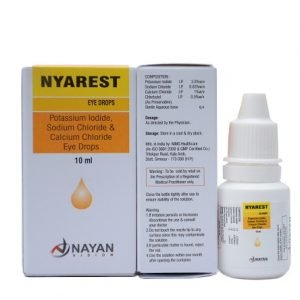Description
Loteprednol (as Loteprednol Etabonate) is a topical corticoid anti-inflammatory. It is used in ophthalmic solution for the treatment of steroid responsive inflammatory conditions of the eye such as allergic conjunctivitis, uveitis, acne rosacea, superficial punctate keratitis, herpes zoster keratitis, iritis, cyclitis, and selected infective conjunctivitides. As a nasal spray, is used for the treatment and management of seasonal allergic rhinitis.
PHARMACOLOGY
PHARMACODYNAMICS
Loteprednol etabonate (LE) is a “soft” steroid belonging to a unique class of glucocorticoids. LE possesses a metabolically labile 17 beta-chloromethyl ester function which was designed in order to be hydrolyzed to an inactive carboxylic acid moiety. This inactive metabolite is more hydrophilic and is thus readily eliminated from the body. Loteprednol etabonate has good ocular permeation properties and good skin permeation properties similar to “hard” steroids. It is used as a topical agent for the treatment of steroid responsive inflammatory conditions of the eye such as allergic conjunctivitis, uveitis and iritis.
MECHANISM OF ACTION: – Loteprednol etabonate (LE) is a “soft” steroid belonging to a unique class of glucocorticoids. Loteprednol etabonate is structurally similar to other glucocorticoids. However, the number 20 position ketone group is absent. It is highly lipid soluble which enhances its penetration into cells. Loteprednol etabonate is synthesized through structural modifications of prednisolone- related compounds so that it will undergo a predictable transformation to an inactive metabolite. It first binds to the type II glucocorticoid receptor. Corticosteroids inhibit the inflammatory response to a variety of inciting agents and probably delay or slow healing. They inhibit the edema, fibrin deposition, capillary dilation, leukocyte migration, capillary proliferation, fibroblast proliferation, deposition of collagen, and scar formation associated with inflammation. There is no generally accepted explanation for the mechanism of action of ocular corticosteroids. However, corticosteroids are thought to act by the induction of phospholipase A2 inhibitory proteins, collectively called lipocortins. It is postulated that these proteins control the biosynthesis of potent mediators of inflammation such as prostaglandins and leukotrienes by inhibiting the release of their common precursor arachidonic acid. Arachidonic acid is released from membrane phospholipids by phospholipase A2.
PHARMACOKINETICS
- ABSORPTION: – Very limited systemic absorption, but good absorption at the point of delivery.
- METABOLISM: – The drugs 17 beta-chloromethyl ester function is hydrolyzed to an inactive carboxylic acid moiety.
INDICATION
- treatment of steroid responsive inflammatory conditions of the eye such as allergic conjunctivitis, uveitis, acne rosacea, superficial punctate keratitis, herpes zoster keratitis, iritis, cyclitis, and selected infective conjunctivitides.
- As a nasal spray, used for the treatment and management of seasonal allergic rhinitis.
- This medication is used to treat certain eye conditions due to inflammation or injury.
- It is also used after eye surgery.
- Loteprednol works by relieving symptoms such as swelling, redness, and itching.
- It belongs to a class of drugs known as corticosteroids.













